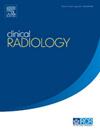Nonrigid temporal registration of multiphase CT pulmonary angiography using low-kV and low contrast: a feasibility study with dual-source CT
IF 2.1
3区 医学
Q2 RADIOLOGY, NUCLEAR MEDICINE & MEDICAL IMAGING
引用次数: 0
Abstract
Aim
This study aimed to compare the nonrigid temporal registration of multiphase computed tomography pulmonary angiography (CTPA) with single-phase CTPA in terms of radiation dose, contrast agent usage, objective and subjective image quality.
Materials and Methods
Consecutive patients suspected of acute pulmonary embolism were prospectively included in this study, and randomly received multiphase or single-phase CTPA. Regarding the contrast media, 15 mL was applied in the multiphase CTPA in comparison with 40 mL applied in the single-phase CTPA. Temporal registration was performed for multiphase CTPA during post-processing. Two experienced radiologists independently evaluated the image quality (IQ) based on objective measurements, subjective impression and diagnostic confidence. Patient demographics, scan parameters and image quality were compared between the two groups.
Results
A total of 72 patients were analysed (37 multiphase CTPA and 35 single-phase CTPA). Positive pulmonary embolism was confirmed in five and seven patients, respectively. The two patient groups had similar demographics besides older age in those who underwent single-phase CTPA. Radiation dose and the contrast-to-noise ratio (CNR) were also similar between groups except for the CNR in the right main pulmonary artery. Both readers rated the multiphase CTPA with a statistically superior subjective IQ over the single-phase CTPA. The diagnostics confidence of the two CTPA protocols was similarly rated by one reader and slightly different according to the second reader.
Conclusion
The nonrigid temporal registration of multiphase CT pulmonary angiography could offer similar or even better image quality than the single-phase protocol and significantly reduce the amount of contrast usage.
低kv低对比多期CT肺血管造影的非刚性时间定位:双源CT的可行性研究
目的比较多相肺血管造影(CTPA)与单相CTPA的非刚性时间配准在辐射剂量、造影剂使用、客观和主观图像质量等方面的差异。材料与方法前瞻性纳入疑似急性肺栓塞的连续患者,随机接受多期或单期CTPA治疗。造影剂在多相CTPA中使用15 mL,而在单相CTPA中使用40 mL。后处理时对多阶段CTPA进行时间配准。两名经验丰富的放射科医生根据客观测量、主观印象和诊断信心独立评估图像质量(IQ)。比较两组患者的人口学特征、扫描参数和图像质量。结果共分析72例患者,其中37例为多期CTPA, 35例为单期CTPA。肺栓塞阳性分别为5例和7例。除了接受单期CTPA的患者年龄较大外,两组患者具有相似的人口统计学特征。除右肺动脉主动脉的CNR外,两组间辐射剂量和噪声比(CNR)也相似。两名读者都认为多相CTPA的主观智商在统计上优于单相CTPA。两种CTPA方案的诊断置信度被一个读者相似地评价,并根据第二个读者略有不同。结论多期CT肺血管造影的非刚性时间配准可以提供与单相方案相似甚至更好的图像质量,并显著减少造影剂的使用。
本文章由计算机程序翻译,如有差异,请以英文原文为准。
求助全文
约1分钟内获得全文
求助全文
来源期刊

Clinical radiology
医学-核医学
CiteScore
4.70
自引率
3.80%
发文量
528
审稿时长
76 days
期刊介绍:
Clinical Radiology is published by Elsevier on behalf of The Royal College of Radiologists. Clinical Radiology is an International Journal bringing you original research, editorials and review articles on all aspects of diagnostic imaging, including:
• Computed tomography
• Magnetic resonance imaging
• Ultrasonography
• Digital radiology
• Interventional radiology
• Radiography
• Nuclear medicine
Papers on radiological protection, quality assurance, audit in radiology and matters relating to radiological training and education are also included. In addition, each issue contains correspondence, book reviews and notices of forthcoming events.
 求助内容:
求助内容: 应助结果提醒方式:
应助结果提醒方式:


